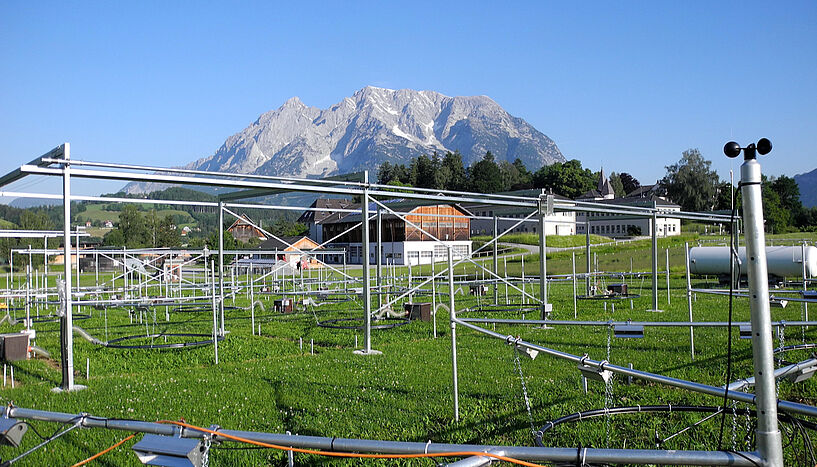Soil bacteria prevail despite drought conditions
29. September 2023
Fig. 1: ClimGrass, the field experiment in Styria, in which drought is simulated in combination with future climate conditions. C: Markus Herndl, HBLFA Raumberg-Gumpenstein
Real-world climate change experiment reveals surprising soil response
Recent research uncovers the resilience of certain soil microorganisms in the face of increasing drought conditions. While many bacteria become inactive during dry spells, specific groups persist and even thrive. This study, conducted by the Centre for Microbiology and Environmental Systems Science (CeMESS) at the University of Vienna, offers ground-breaking insights into bacterial activity during drought periods, with implications for agriculture and our understanding of climate change impacts. The study has been published in the renowned scientific journal Nature Communications.
The images of the parched Po Valley in 2022 and this year's forest fires in Greece underscore the reality of extreme droughts – not just as news headlines but as immediate threats. The repercussions for humans and plant life are evident: crop failures, withered meadows, and water rationing. However, the impact of drought on soil microorganisms remains hidden from the naked eye.
Soil microorganisms play a pivotal role in ecosystems. They contribute to soil fertility, assist plants in nutrient absorption, and determine whether soils store or release CO2, thereby influencing climate change trajectories. Until now, measuring the activity of microorganisms in dry soils and identifying which species remain active was challenging. Thanks to a novel method developed by scientists at the University of Vienna, bacterial activity during drought periods can now be observed.
New method uses water vapor to measure bacterial activity
In the study, recently published in "Nature Communications", soil samples from the "ClimGrass" climate change experiment in Styria were incubated with isotopically-marked water vapor. Growing bacteria incorporated the oxygen from the water vapor into their DNA, allowing for a measure of growth without adding liquid water to the soil.
"Most bacteria became inactive as dryness increased. However, this wasn't uniform across all microbial groups," explains Dennis Metze, PhD student and lead author of the study. Moreover, bacterial growth during drought was influenced by whether the soils had been exposed to current or future climatic conditions, i.e., higher temperatures and CO2 concentrations.
Microbial communities could become more drought tolerant in future
In the heart of Styria, the "ClimGrass" experiment paints a vivid picture of the future. Here, 54 experimental plots simulate the world of tomorrow. Infrared heaters elevate temperatures to levels expected in future climate scenarios, while miniFACE systems adjust atmospheric CO2 concentrations. Automated rainout shelters mimic severe summer drought events, creating a tangible representation of the challenges our ecosystems might face.
"Simulating future climate conditions actually resulted in more bacteria remaining active despite drought," explains Andreas Richter, professor of ecosystem research and head of CeMESS. "Under these simulated conditions, more drought-tolerant species were able to establish." A particularly drought-resistant bacterium from the Streptomyces genus became more prevalent in dry soils, accounting for a significant portion of total bacterial activity.
The filamentous growth of this bacterium might allow it to bridge disconnected pore spaces in drought-stricken soils, enabling it to access water and nutrients from distant sources. Previous studies have indicated that such bacteria might play a role in aiding plants to cope with drought.
The findings of this study offer invaluable insights into the resilience and adaptability of soil microorganisms in the face of increasing droughts due to climate change. As these tiny organisms play a monumental role in maintaining soil fertility, aiding plant growth, and regulating carbon sequestration, understanding their behaviour is crucial for both our ecosystems and agricultural sectors.
As the world grapples with the challenges of climate change, food security, and ecosystem balance, research like this paves the way for informed strategies to safeguard our planet's health and the well-being of its inhabitants.
Original publication:
Metze, D., Schnecker, J., Canarini, A., Fuchslueger, L., Koch, B., Stone, B., Hungate, B. Hausmann, B., Schmidt, H., Schaumberger, A., Bahn, M., Kaiser, C. & Richter, A. Microbial growth under drought is confined to distinct taxa and modified by potential future climate conditions. Nature Communications 14, 5895 (2023).
DOI: 10.1038/s41467-023-41524-y
Picture:
Fig. 1: ClimGrass, the field experiment in Styria, in which drought is simulated in combination with future climate conditions. C: Markus Herndl, HBLFA Raumberg-Gumpenstein
Scientific contact
Univ.-Prof. Dr. Andreas Richter
Zentrum für Mikrobiologie und UmweltsystemwissenschaftUniversität Wien
1090 - Wien, Althanstraße 14 (UZA I)
+43-1-4277-76660
+43-664-60277-76660
andreas.richter@univie.ac.at
Further inquiry
Mag. Alexandra Frey
Media Relations ManagerUniversität Wien
1010 - Wien, Universitätsring 1
+43-1-4277-17533
+43-664-8175675
alexandra.frey@univie.ac.at
Downloads:
20230929_Richter_Abb1_01.jpg
File size: 3,51 MB
